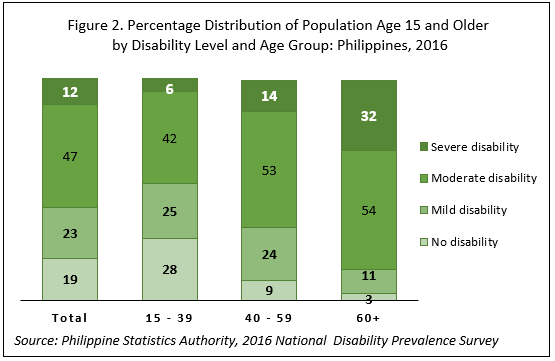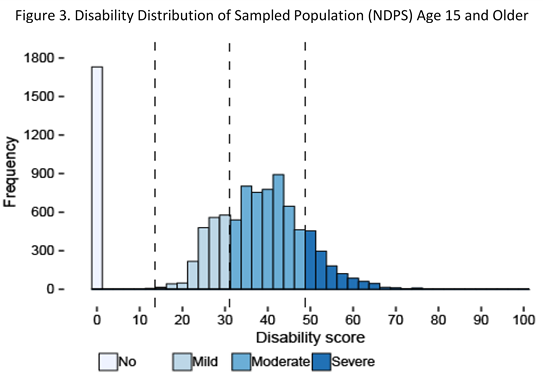Disability prevalence in the Philippines registers at 12 percent
Results of the National Disability Prevalence Survey (NDPS) showed that, in 2016, around 12 percent of the Filipinos age 15 and older experienced severe disability (Figure 1). Almost one in every two (47%) experienced moderate disability while 23 percent with mild disability. Almost one-fifth (19%) experienced no disability. In this survey, the disability prevalence rate corresponds to the percentage of persons with severe disability.

Females more likely than males to experience severe and moderate disability
A higher percentage of females than males experienced severe disability (15% and 9%, respectively) (Figure 1). Those who experienced moderate disability level were also higher for females at 49 percent than for males at 45 percent. For mild disability, about 25 percent of males while 20 percent of females experienced it.
Almost a third of population age 60 and older experience severe disability
The percentage of persons age less than 60 who experienced mild disability is 23 percent to 25 percent (Figure 2). More than one in two persons (53% to 54%) age at least 40 experienced moderate disability. Almost one in every three persons (32%) with severe disability belonged to the older population age group of 60 and older.

About the Survey
The NDPS/MFS is a nationwide survey which covered around 11,000 sample households, with one member, age 15 years or older, randomly selected in each sample household yielding a total of 10,240 completed interviews of sample individuals.
This survey is a general population survey and there are no filters in selecting the individual samples, hence, each individual selected in the household is the respondent for the individual questionnaire regardless of his/her health condition.
LISA GRACE S. BERSALES, Ph.D.
Undersecretary
National Statistician and Civil Registrar General
Technical Notes
The PSA conducted the National Disability Prevalence Survey or Model Functioning Survey (NDPS/MFS) in 2016 adopting the Model Disability Survey (MDS) developed by the World Health Organization (WHO) and the World Bank (WB). The MDS is grounded on the International Classification of Functioning, Disability and Health (ICF). In the MDS, disability is not understood as something one might have or not have. And it is not an internal attribute of a person but an experience. Also, disability is not something that cause or contribute to the development of a disease or condition.
Disability as a Continuum
The WHO concept or understanding of disability is the outcome of the interaction between the health conditions and impairments of an individual and his/her environment whether physical, social, attitudinal and/or political. Disability is a continuum, a matter of degree ranging from no disability (0 score) to extreme disability (100 score). Based on this concept, disability is universal, meaning every person sits somewhere on the disability continuum.
Disability levels of respondents were measured by answering a series of questions in 17 functioning domains namely: mobility, hand and arm use, self-care, seeing, hearing, pain, energy and drive, breathing, affect (depression and anxiety), interpersonal relationship, handling stress, communication, cognition, household tasks, community and citizenship participation, caring for others, and work and schooling. The answers of the respondents were given equivalent scores and based on the scores, each respondent was classified as to having: “no disability”, “mild disability”, “moderate disability” and “severe disability”.
The WHO recommendation on the cut-offs depend on the purpose: (1) Severe disability rates? (2) Eligibility for disability benefits? (3) Allocation of health resources? These cut-offs are as follows:
Cut-off criteria in classifying levels of disability recommended by the WHO
Target LevelCut-off-Criteria
No DisabilityScore < (Mean – 1SD) or Score = 0
Mild(Mean – 1SD) < Score < Mean
ModerateMean < Score < (Mean + 1SD
SevereScore ≥ (Mean + 1SD)
The disability continuum or the disability distribution represents the individual scores with the dotted lines as cut-offs indicating the boundaries of the different levels of disability. The disability continuum for the Philippines based on the NDPS sample given in Figure 3 shows that Filipinos, age 15 and older, tend to experience moderate disability.

